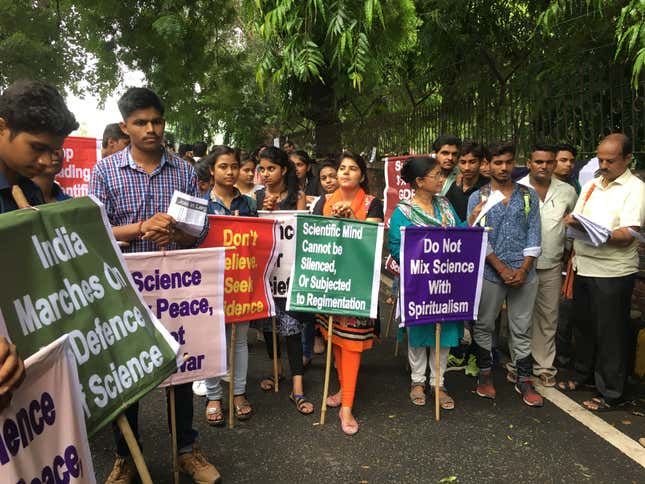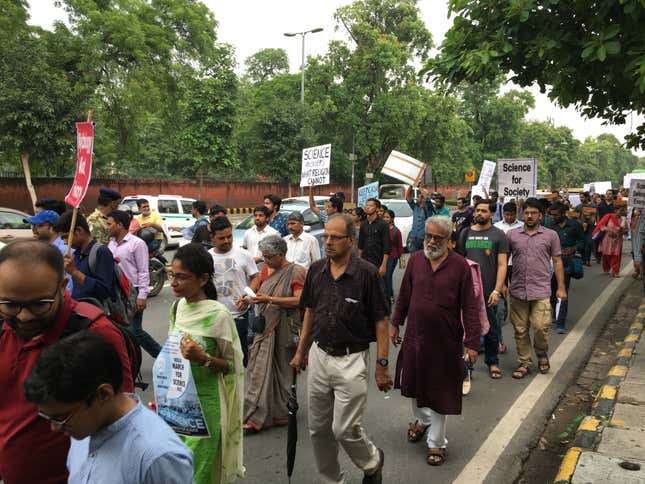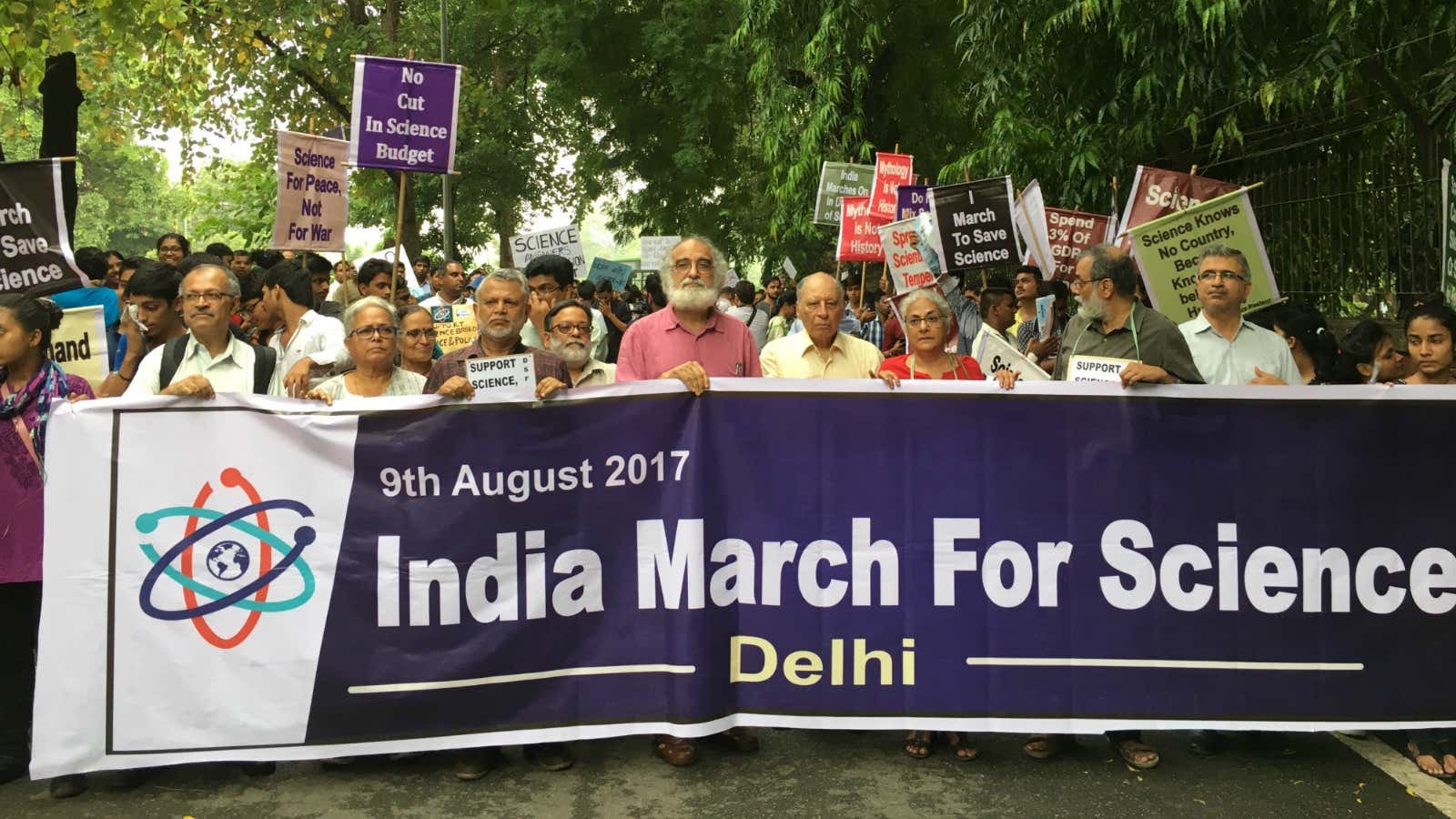Chennai/New Delhi
Suresh Govindarajan spent Wednesday (Aug. 09) evening walking the length of Chennai’s Elliot’s Beach in silent protest.
The professor of physics at the prestigious Indian Institute of Technology Madras (IIT-M) wasn’t alone. A few hundred students, academics, scientists, and engineers, too, braved the rain, held up placards, and marched along the beachfront.
“There is a subtle diversion of funds from science to what is considered as possible science,” said Govindarajan, a tall theoretical physicist, who studied at IIT-M and the University of Pennsylvania. “They (the government) are willing to give money for various research on the cow or something, but even at a place which is well-endowed, like IIT, we are facing issues…”
Some 2,000 kilometres away, in India’s capital city of New Delhi, 150-odd students, teachers, and engineers marched over two kilometres from Mandi House to Jantar Mantar amidst peak traffic on a sultry evening. Their demands were the same as their counterparts in Chennai: an increase in funding for real scientific research in India and a stop to the practice of mixing Hindu mythology and science.
In all, the scientific community staged protests—the first such nationwide demonstration in recent times—in 26 other cities, including Mumbai, Thiruvananthapuram, and Bengaluru. The organisers claim that some 10,000 protestors took to the streets, including nearly 1,000 scientists, partly inspired by the March for Science, a series of worldwide rallies held on April 22, Earth Day.
“This isn’t a political message,” said Soumitro Banerjee, a professor at the Indian Institute of Science Education and Research (IISER), Kolkata, and a member of the Breakthrough Science Society (BSS), an association of scientists that helped organised the protest. “The problem is that there is propagation of unscientific views and superstitions, sometimes that is even getting support from the governmental quarters…there was a lot of displeasure among the scientific community about this.”
Funding constraints
Over the past few years, India’s spending on science and technology, as a share of its GDP, has remained at a paltry 0.8%.
Much of that is spent on space technology, leaving little for other areas, particularly fundamental research. The protesters who took to the streets on Wednesday want that to change, seeking an increase in government funding to more than 3% of GDP—on par with many developed economies. Even among the BRICS nations, Brazil, Russia, and China spend over 1% of their GDP towards scientific research.
In 2015, the Modi government had asked organisations involved in scientific research to start “self-financing” projects, which meant they would have to raise their own funding for research. This was part of the 2015 Dehradun Declaration that directed government-controlled laboratories and research institutes in India to “develop a revenue model in a business-like manner with a clear cost-benefit analysis” and become self-financing in two years. But, without budgetary support, India’s scientific research organisations seem to be struggling.
For instance, the Council of Scientific and Industrial Research (CSIR), India’s largest research and development organisation that runs some 37 labs across the country, is facing a severe cash crunch. Despite repeated pleas, CSIR has been unable to secure more funding from the Modi government. Meanwhile, CSIR staff were reportedly barred from attending the March for Science by the organisation’s director.
“There is a loss of recognition of the significance of fundamental research in India,” said Dhruv Raina, a professor at Jawaharlal Nehru University and one of India’s leading science historians who attended the protest in New Delhi. “While a focus on vocational education is important, the research capabilities developed over the last 70 years cannot be undermined. The clamour for a knowledge-based society has grown, the conditions required for its sustenance seems to be found wanting due to a shift in policy at the national and global level.”

Kill pseudo-science
The nationwide protest was also a reaction to the government’s obsession with mixing up religion and science.
Since 2014, when the Modi government took charge, various ministers and party lawmakers have tried to combine religious mythology with science to show the advanced state of Hindu thought. These include specious claims that ancient Indians built inter-planetary aircraft and practiced cosmetic surgery—none less than the Indian prime minister cited the elephant-headed Hindu god, Ganesh, as an example.
Moreover, the growing obsession over cows and the government’s push to study the benefits of panchagavya—a mixture of five cow products: urine, dung, milk, ghee, and curd—has also caused concern. In fact, the Indian Institute of Technology Delhi has received 50 proposals from top research institutions to explore the benefits of the panchagavya.

“There has been an acceleration in pseudo-science in recent times,” said Banerjee of IISER. “For science to thrive, people have to not believe things that they are told without evidence. A society must always question. If that doesn’t happen, it is extremely worrisome.” But that ability to question has increasingly come under threat. For instance, between 2014 and 2015, three of India’s most prominent rationalists—Govind Pansare, Narendra Dabholkar, and MM Kalburgi—were killed by unknown assailants.
“An environment of anti-science is developing in various forms,” said TR Govindarajan, a professor at the Institute of Mathematical Sciences in Chennai. “For example, people are suggesting that during the lunar eclipse, don’t eat anything or drink anything…we thought those days were gone, but now it is coming back.”
